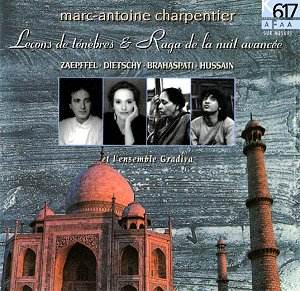|
|
Search MusicWeb Here |
|
 |
||
|
Founder:
Len Mullenger (1942-2025) Editor
in Chief:John Quinn
|
|
|
Search MusicWeb Here |
|
 |
||
|
Founder:
Len Mullenger (1942-2025) Editor
in Chief:John Quinn
|
 |
Marc-Antoine CHARPENTIER
Leçons de ténèbres and Raga de la nuit avancée 1. Ouverture : Tabla 1’43" 2. 1ère leçon du vendredi Saint 10’55" 3. 2ème leçon du jeudi Saint 14’34" 4. Raga de la Minuit 23’11" 5. 3ème leçon du mercredi Saint 11’53" 6. Bhajan 8’02" Sulochana Brahaspati voice Veronique Dietschy soprano Alain Zaepffel counter-tenor Recordings made in the church of St-Jean de Grenelle in September 1991 |
| CD available for post-free online mail-order or you may download individual tracks. For some labels you can download the entire CD with a single click and make HUGE savings. The price you see is the price you pay! The full booklet notes are available on-line. | |
|
NOTE • Click on the button and you can buy the disc or read the booklet details • You can also access each track which you may then sample or down load. • Further Information. |
|
|
The reader could be forgiven for looking twice at the title of this disc, but it is not a printing error. This CD does juxtapose the music of Marc-Antoine Charpentier with that of Northern Indian classical music. Why?
According to the booklet the thought was "that the Ragas - melodic, emotional modes linked to the hours of the day and the seasons - had much in common with the meditative tenebrae of holy week. Also, because of their sacred character and the subtile exploration of a [sic.] emotion through the written or improvised ornementation [sic.] of the vocal line, these two types of night music seemed to us to draw together and sharpen the experience of its interpreters." It might sharpen the experience of the interpreters but it does nothing for the poor listener. The implication of the pretentious waffle that passes for a booklet note is that these two types of music are performed at night and involve a certain amount of vocal ornamentation. This is in no way enough of a reason to justify the juxtaposition of the glaring dissimilarities that do nothing but grate when put into such proximity. This is a great shame, because both are interesting musics worth listening to. A complete disc of each would have made a viable two CD set but the interpolation of a set of tenebrae with a 23 minute raga that should stand on its on just doesn’t work. The joins are abrupt and unprepared; the styles too disparate to meld one into the other, and the addition of the tabla to the third tenebrae is just a disaster. Both tabla playing and French baroque singing have significant features to do with rhythm, but they are pulling in opposite directions; the function of the tabla is too maintain rhythmic momentum - to move music forward; the function of rhythm in the French baroque is to shape and stretch the small phrase or gesture. Inégale is unknown in tabla playing and the poor tabla player (who doesn’t get named in the booklet or on the CD except as a putative "Hussain" on the front cover) has no way of dealing with cadential rubato in his musical language. (sample 1) Therefore, why was no recording producer able to notice that this doesn’t work and do something about it?
The Midnight Raga is an impressive piece itself and the performance of Sulochana Brahaspati is undeniably powerful.(Sample 2) In comparison, Veronique Dietschy and Alain Zaepffel are not quite as convincing, although the performances of the tenebrae have many attractive moments. (sample 3) Dietschy’s soprano is rather thin in places, and this detracts from the opulence of Charpentier's melodic writing. In comparison with the admirable performances by Agnes Mellon and Il Seminario Musicale there is a feeling of being in a different league.
There are further problems in the tenebrae in that the first and second leçons are joined together without the intervening Jerusalem section with which each ends. According to the booklet this ‘is based on the principle that the order of the works performed for this recording was chosen to form a single tenebrae office or ... a single great night raga." Rubbish! These pieces are written to be performed on separate days throughout Holy Week. Converting them into "bleeding chunks" then putting the chunks next to each other in the hope of creating a body is doing nothing for the music, and is obscuring its purpose for the listener. This seems to be a classic case of the marketing idea taking over the material to be marketed. The tenebrae lessons are not a Raga, even if they share some similarities of purpose. Trying to turn them into one does not improve them. A separate recording of these two types of music would be enjoyable. This odd concoction is not recommendable.
Peter Wells
|
| ADDITIONAL INFORMATION •
You can sample only 30 seconds (or 15% if that is longer) of a given track. Select from the View tracks list. Each sample will normally start from the beginning but you can drag the slider to any position before pressing play. • PLEASE NOTE: If you are behind a firewall and the sound is prematurely terminated you may need to register Ludwig as a trusted source with your firewall software.
•You will need Quicktime to hear sound samples. Get a free Quicktime download here • If you cannot see the "Sample All Tracks" button you need to download Flash from here.
|
|
|
Return to Index |